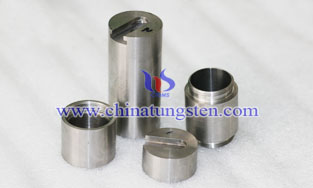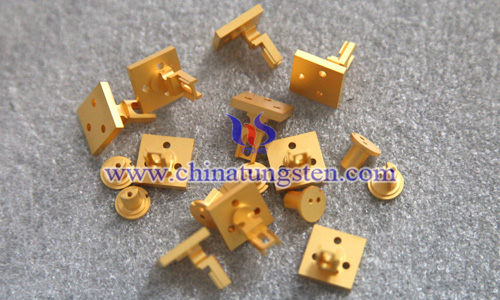China Ammonium Paratungstate Market (APT Market) On July 9,2013
- Details
- Category: Tungsten's News
- Published on Tuesday, 09 July 2013 17:06
- Hits: 2395
China ammonium paratungstate prices(APTprices) continues to be firm.
China ammonium paratungstate market(APT market) keeps quiet, and the APT prices are stable this week.
However, as the tungsten concentrate prices hover at high level, some APT suppliers raise offers. The ammonium paratungstate market(APT market) sees some higher offers.
A source from an APT factory based in South China noted that they mainly dealt with the old orders in the recent days.
You can visit the following links for more information about ammonium paratungstate prices(APT prices).
Tungsten Manufacturer & Supplier: Chinatungsten Online - http://www.chinatungsten.com
Tel.: 86 592 5129696; Fax: 86 592 5129797
Email: sales@chinatungsten.com
Tungsten Picture Center: http://picture.chinatungsten.com
Tungsten Video Center: http://v.chinatungsten.com
Tungsten News & Tungsten Prices, 3G Version: http://3g.chinatungsten.com
European Ammonium Paratungstate Market (APT Market) On July 9,2013
- Details
- Category: Tungsten's News
- Published on Tuesday, 09 July 2013 17:01
- Hits: 2416
European ammonium paratungstate market(APT market) sales prices increase as buying activity sees small improvement.
European ammonium paratungstate market(APT market) buying activity has picked up over the past 2-3 days as downstream users come back into the market to restock inventories and potentially cover against the rising export prices of tungsten products from China.
Sales were completed either side of USD400mtu towards the back end of last week, although APT sales concluded on Monday were reaching USD405mtu in warehouse Rotterdam according to market participants.
You can visit the following links for more information about ammonium paratungstate prices(APT prices).
Tungsten Manufacturer & Supplier: Chinatungsten Online - http://www.chinatungsten.com
Tel.: 86 592 5129696; Fax: 86 592 5129797
Email: sales@chinatungsten.com
Tungsten Picture Center: http://picture.chinatungsten.com
Tungsten Video Center: http://v.chinatungsten.com
Tungsten News & Tungsten Prices, 3G Version: http://3g.chinatungsten.com
Further Testing On A Larger Sample Is Scheduled In South Africa
- Details
- Category: Tungsten's News
- Published on Tuesday, 09 July 2013 11:50
- Hits: 2373
Further testing on a larger sample is scheduled in South Africa, which will allow Thor to better predict commercial outcomes, it said.
Chairman Mick Billing said: "This is a potentially exciting enhancement for the Spring Hill project. Ore sorting is also commercially used in tungsten processing and a similar scale test on Molyhil material is also in process in South Africa."
"We eagerly await the outcome of that testwork, as it also has potential to reduce both capital and operating costs for Molyhil," he added.
Tungsten Manufacturer & Supplier: Chinatungsten Online - http://www.chinatungsten.com
Tel.: 86 592 5129696; Fax: 86 592 5129797
Email: sales@chinatungsten.com
Tungsten Picture Center: http://picture.chinatungsten.com
Tungsten Video Center: http://v.chinatungsten.com
Tungsten News & Tungsten Prices, 3G Version: http://3g.chinatungsten.com
Thor Mining Reports Positive Tests At Australian Gold Project
- Details
- Category: Tungsten's News
- Published on Tuesday, 09 July 2013 11:39
- Hits: 2311
AIM-listed mineral and development company Thor Mining said it has had positive results from initial ore sorting test work on near surface oxide ore from the Spring Hill gold project south of Darwin in Australia's Northern Territory.
Spring Hill gold mineralisation is vein hosted and the positive results, using X-ray scanning, demonstrate 'proof of concept' that gold bearing material can be identified and segregated.
Tungsten Manufacturer & Supplier: Chinatungsten Online - http://www.chinatungsten.com
Tel.: 86 592 5129696; Fax: 86 592 5129797
Email: sales@chinatungsten.com
Tungsten Picture Center: http://picture.chinatungsten.com
Tungsten Video Center: http://v.chinatungsten.com
Tungsten News & Tungsten Prices, 3G Version: http://3g.chinatungsten.com
Hejiang River Pollution Is Under Control
- Details
- Category: Tungsten's News
- Published on Tuesday, 09 July 2013 11:15
- Hits: 2399
Bi Haidong, deputy mayor of Hezhou, said some small mining companies frequently conduct illegal mineral exploitation and washing, and discharge waste without treatment, which can result in pollution.
Hezhou has huge reserves of minerals, including manganese, tungsten, rare earths, cadmium and thallium.By Sunday evening, the cadmium density in the section of the river between Guangxi and Guangdong had fallen below standard.
while that of thallium remained beyond the allowed maximum level, according to the local environmental protection department."The monitoring data was not good, but the situation is under control," said Bi.
Tungsten Manufacturer & Supplier: Chinatungsten Online - http://www.chinatungsten.com
Tel.: 86 592 5129696; Fax: 86 592 5129797
Email: sales@chinatungsten.com
Tungsten Picture Center: http://picture.chinatungsten.com
Tungsten Video Center: http://v.chinatungsten.com
Tungsten News & Tungsten Prices, 3G Version: http://3g.chinatungsten.com
112 Enterprises Had Been Investigated For Hejiang River Pollution
- Details
- Category: Tungsten's News
- Published on Tuesday, 09 July 2013 11:10
- Hits: 2393
In neighboring Guangdong Province, the local government of downstream Fengkai county expressed concerns over the tainted water Saturday, the Nandu Daily reported, adding that the county has stopped using the river as its main drinking water source and regularly tested samples.
Hezhou has huge reserves of minerals, including manganese, tungsten, rare earths, cadmium and thallium.The official from Hezhou also said the pollution would be cleared within two weeks and other mining companies along the river should be checked.
As of Sunday, 112 enterprises along the river had been ordered to suspend operations for investigation after dead fish have been found in a section of the river since July 1, the Xinhua News Agency reported.
Tungsten Manufacturer & Supplier: Chinatungsten Online - http://www.chinatungsten.com
Tel.: 86 592 5129696; Fax: 86 592 5129797
Email: sales@chinatungsten.com
Tungsten Picture Center: http://picture.chinatungsten.com
Tungsten Video Center: http://v.chinatungsten.com
Tungsten News & Tungsten Prices, 3G Version: http://3g.chinatungsten.com
Illegal Mineral Processing To Blame For Hejiang River Pollution
- Details
- Category: Tungsten's News
- Published on Tuesday, 09 July 2013 11:07
- Hits: 2394
The illegal processing of minerals and discharge of sewage by a mining company is to blame for the water pollution in the Hejiang River in the Guangxi Zhuang Autonomous Region, a local official confirmed to the Global Times Monday.
A press officer from the city government of Hezhou said the Huiwei Mineral Processing Plant, one of the 112 mining companies along the river, is responsible for the excessive levels of thallium and cadmium found in the river.
The plant's owner, surnamed Gong, has also been detained, said the official, adding that the plant was also found to be secretly processing indium, a soft metal found in zinc, which has produced waste, including thallium and cadmium that was discharged in the river.
Tungsten Manufacturer & Supplier: Chinatungsten Online - http://www.chinatungsten.com
Tel.: 86 592 5129696; Fax: 86 592 5129797
Email: sales@chinatungsten.com
Tungsten Picture Center: http://picture.chinatungsten.com
Tungsten Video Center: http://v.chinatungsten.com
Tungsten News & Tungsten Prices, 3G Version: http://3g.chinatungsten.com
Tungsten Tipped to Become Scarce from 2015
- Details
- Category: Tungsten's News
- Published on Tuesday, 09 July 2013 09:49
- Hits: 2414
Tungsten is one of a number of “critical elements” that will become increasingly scarce from 2015, according to a well-known mining consultant.
Lara Smith, managing director of South African group Core Consultants, told the Geological Society of South Africa that tantalum and certain types of rare earths would also be become much harder to find over the next three years.
The European Union and the US Department of Defence have already put these three metals at the top of their critical list.
China is the world’s main producer of tungsten but is now the major user as well. The Chinese already account for more than half of world appetite and with thier tungsten demand growing rapidly, they have adopted measures to protect supplies.
This is throwing up huge opportunities for the development of tungsten ores, concentrates and intermediary products outside of China, said Smith.
The growth in demand has necessitated the sale of government stockpiles, Smith asserted, adding that the market is likely to face a 15,000 tonne (t) deficit this year. According to the US Geological Survey, the US stockpile has already fallen from around 35,500t to 7,500t over the past ten years.
Rising Chinese inflation is also likely to push tungsten prices higher. A number of companies in Europe are in the process of establishing new tungsten mines to try to meet the expected gap in supplies. Ormonde Mining (LON:ORM) is awaiting final permitting for its Barruecopardo tungsten mine in Spain that will produce 227,000 tonnes per year. W Resources (LON:WRES) is also busy in Spain, exploring and defining a new mine and tailings treatment plant at La Parilla in the south-west of the company. In the UK, Wolf Minerals (LON:WLFE) has just started development of its Hemerdon project in Devon having agreed a financing package in May.
Tungsten Manufacturer & Supplier: Chinatungsten Online - http://www.chinatungsten.com
Tel.: 86 592 5129696; Fax: 86 592 5129797
Email: sales@chinatungsten.com
Tungsten Picture Center: http://picture.chinatungsten.com
Tungsten Video Center: http://v.chinatungsten.com
Tungsten News & Tungsten Prices, 3G Version: http://3g.chinatungsten.com
Tungsten More “Critical” on Expected Supply Shortage
- Details
- Category: Tungsten's News
- Published on Tuesday, 09 July 2013 09:37
- Hits: 2403
It certainly isn’t news to anyone that tungsten is a critical metal. However, it is important to note that tungsten is slowly making its way up the global critical metals list.
A metal is deemed critical when it is found to be economically important to the functionality of society, but has a high risk of supply disruptions. In 2011, The British Geological Society published a list of what it considers the 52 most critical metals in the world. The list was compiled based on global abundance, location of production, reserves and supply risk associated with the political stability in the jurisdictions where the metal occur.
Considering that over 80 percent of tungsten comes from China, and that China is tungsten’s largest consumer, it is not surprising that the metal made the list in 2011. Add to that mine closures, halts in production and overall lack of new supply from mines in the western world, and the outlook for tungsten supply doesn’t look very good.
Tungsten Manufacturer & Supplier: Chinatungsten Online - http://www.chinatungsten.com
Tel.: 86 592 5129696; Fax: 86 592 5129797
Email: sales@chinatungsten.com
Tungsten Picture Center: http://picture.chinatungsten.com
Tungsten Video Center: http://v.chinatungsten.com
Tungsten News & Tungsten Prices, 3G Version: http://3g.chinatungsten.com
Wolf’s Hemerdon Tungsten Project
- Details
- Category: Tungsten's News
- Published on Monday, 08 July 2013 16:51
- Hits: 2458
Indeed there is also the prospect of some fairly small scale gold mines being opened in Scotland and Northern Ireland too, although the prospects for these may be being somewhat damaged by the recent fall back in the gold price.
Wolf’s Hemerdon project involves the re-opening of a tin/tungsten property first discovered in the 1860s and then developed and mined during World War 1, with sporadic production up until the end of World War 2. Infrastructure is good being only some 11 km from the city of Plymouth.
The South West of England – notably western Devon and across the county border in Cornwall - has an extensive mining history having produced copper, tin, tungsten and china clay in a number of mining operations.
Tungsten Manufacturer & Supplier: Chinatungsten Online - http://www.chinatungsten.com
Tel.: 86 592 5129696; Fax: 86 592 5129797
Email: sales@chinatungsten.com
Tungsten Picture Center: http://picture.chinatungsten.com
Tungsten Video Center: http://v.chinatungsten.com
Tungsten News & Tungsten Prices, 3G Version: http://3g.chinatungsten.com









 sales@chinatungsten.com
sales@chinatungsten.com